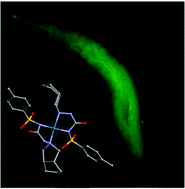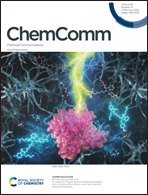A gliclazide complex based on palladium towards Alzheimer's disease: promising protective activity against Aβ-induced toxicity in C. elegans†
Abstract
A new palladium coordination compound based on gliclazide with the chemical formula [Pd(glz)2] (where glz = gliclazide) has been synthesized and characterised. The structural characterization reveals that this material consists of mononuclear units formed by a Pd2+ ion coordinated to two molecules of the glz ligand, in which palladium ions exhibit a distorted plane-square coordination sphere. This novel material behaves like a good and selective inhibitor of butyrylcholinesterase, one of the most relevant therapeutic targets against Alzheimer's disease. Analysis of the enzyme kinetics showed a mixed mode of inhibition, the title compound being capable of interacting with both the free enzyme and the enzyme–substrate complex. Finally, the palladium compound shows promising protective activity against Aβ-induced toxicity in the Caenorhabditis elegans model, which has never been reported.



 Please wait while we load your content...
Please wait while we load your content...